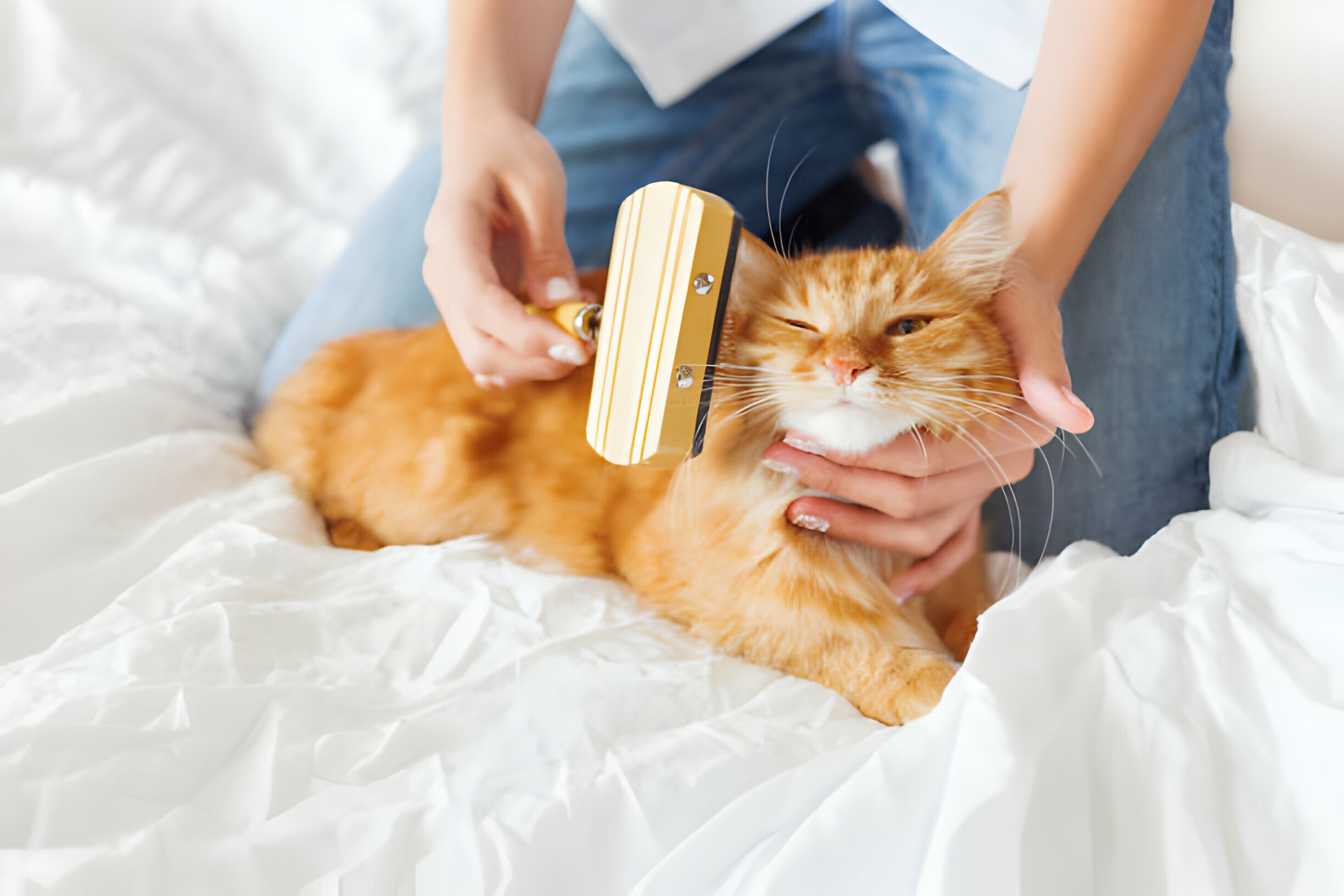Welcome to the Ultimate Guide to Cat Care! Whether you’re a new cat owner or a cat expert, the ultimate guide to cat care has all the information you need to ensure the health, happiness, and well-being of your new furry friend. From understanding their basic needs to addressing common health issues, we’ve got you covered. So, let’s explore the wonderful world of cat care!
Understanding Your Cat’s Needs: Essential Tips from the Ultimate Cat Care Guide
Before jumping into the more complex aspects of cat care, it’s important to understand the basic needs of your new pet. Cats are independent, with unique instincts and behaviors. They need love, attention and a sense of security. Here are some things to consider before adopting a cat into your family:
- Nutrition: Cats are obligate carnivores, meaning they need a diet rich in animal protein because they’re natural hunters. Make sure to feed them with good-quality cat food that has all the nutrients they need.
- Hydration: Cats should always have access to fresh water. Consider using a cat water fountain to make sure they drink enough.
- Litter Box: Keep a clean litter box in a quiet spot that’s easy for your cat to get to. Scoop it out every day and change the litter regularly.
- Scratching Posts: Cats love to scratch! To avoid having your furniture ruined, provide suitable scratching posts.
- Socialization: Spend time playing, cuddling, and doing activities with your cat to keep them mentally, physically and socially happy.
Creating a Safe and Fun Environment
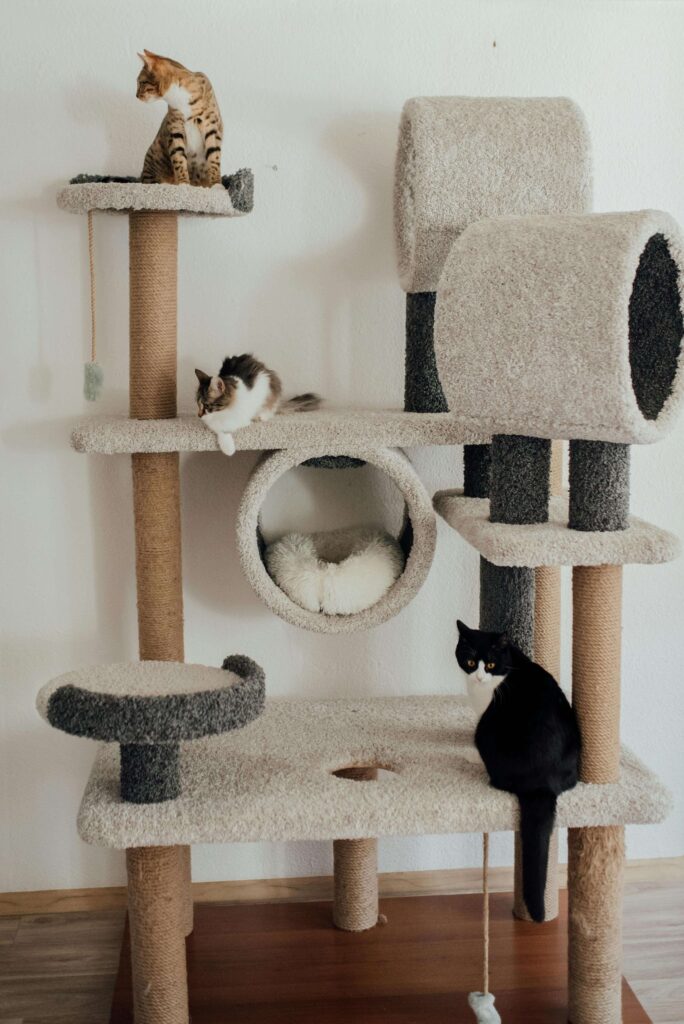
Your cat’s well-being is not only a matter of meeting basic needs, Your cat’s environment plays a very important role, also. Here are a few suggestions to help you make your home a purrfect place for your cat:
- Cat-proof Your Home: Remove toxic plants, secure any loose cords and make sure your cat cannot reach any things that may be harmful to them. Remember, they’re pretty athletic and can be quite the troublemakers.
- Climbing Spaces: Cats love to climb! Give them cat trees or shelves to explore and satisfy their instincts.
- Toys and Games: Keep your cat entertained with toys, puzzle feeders, and games. Don’t forget to switch them up to keep things interesting.
- Cozy spots: Cats love having hiding places where they can feel safe. Try cat tunnels or covered beds for them to relax in.
- Indoor Living: It’s safer to keep your cat indoors to protect them from dangers like traffic, disease, predators and fights with feral cats other or animals. If you want to let them explore the outside world, make sure they do so from a secure and supervised area.
Feeding and Nutrition

Proper nutrition is essential for your cat’s health and longevity. Here’s what you need to know:
- Choosing the Right Food: Pick high-quality cat food suitable for your cat’s age, size, and health. Some cats need special diets due to allergies or medical conditions. Consult your vet for guidance.
- Feeding schedule: Stick to a feeding schedule and control portion sizes to avoid overeating and obesity.
- Water intake: About two-thirds of a cat’s body is made up of water. Cats need it to maintain their health and survive. How much water a cat needs to drink depends on size, activity level, diet and health. Aim to give your cat at least 5-10 fluid ounces per day. Some cats can be quite stubborn when it comes to water. We suggest buying a water fountain to encourage drinking.
- Treats: Offer treats in small amounts occasionally, or to reinforce good behavior. Choose healthy options like cooked unseasoned chicken, beef or turkey, fish, eggs.
Grooming and Hygiene
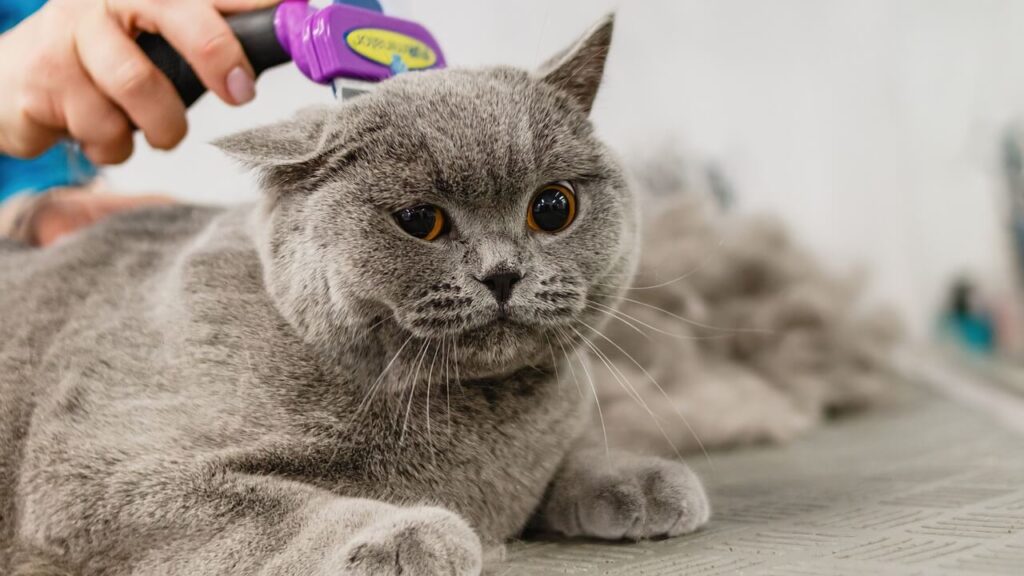
Keeping your cat clean and healthy requires regular grooming and good hygiene practices. Here’s what you need to know:
- Brushing: Prevent matting and hairballs by brushing your cat’s fur regularly. The frequency depends on their coat length and type.
- Bathing: Most cats groom themselves, so baths are rarely needed. However, if your cat gets dirty or has a skin problem, use cat-friendly shampoo and proper bathing techniques.
- Nail Trimming: Trim your cat’s nails to prevent them from becoming too long or sharp. Use cat-specific nail clippers and be careful not to cut the quick.
- Ear Cleaning: Check your cat’s ears for signs of infection or excess wax. Clean them gently with a vet-recommended ear cleaner if necessary.
- Dental Care: Keep your cat’s teeth healthy by brushing regularly with cat-specific toothbrush and toothpaste. You can also offer dental treats or toys to help maintain their oral hygiene.
Healthcare and preventive measures
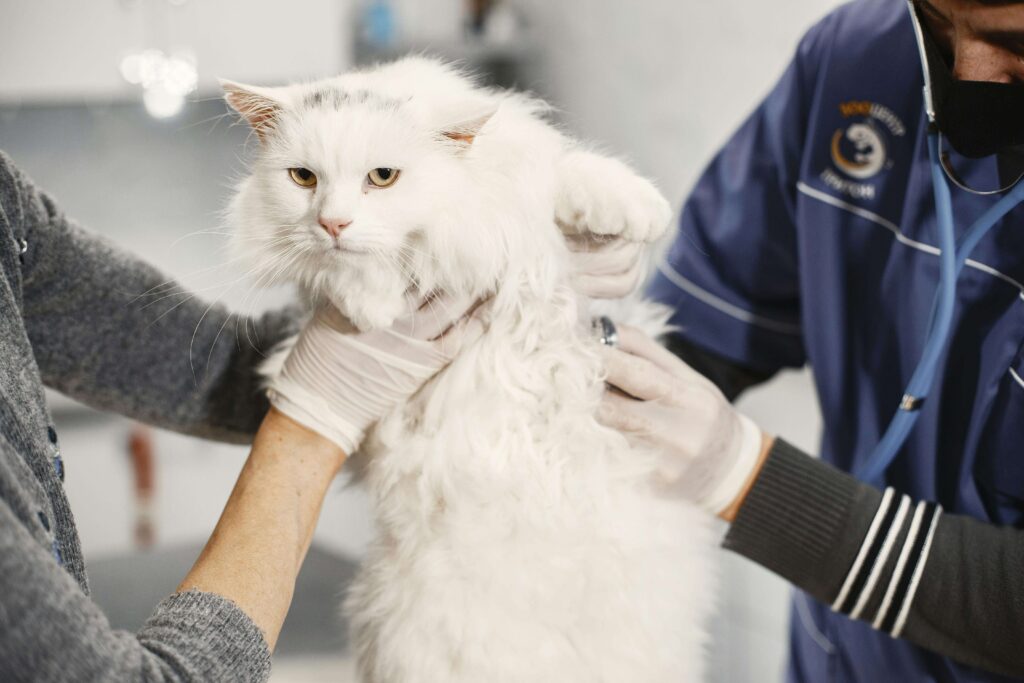
Vaccinations: Keeping your cat’s vaccinations up to date is crucial for protecting them from common diseases like rabies, feline leukemia, and respiratory infections. Your vet can help you create a vaccination schedule tailored to your cat’s needs.
Parasite Control: Protect your cat from pesky parasites like fleas, ticks, and worms. Your vet can recommend safe and effective preventive products to keep these critters at bay. Regular deworming treatments are also important to prevent internal parasites.
Spaying/Neutering: Consider having your cat spayed or neutered to prevent unwanted litters and reduce the risk of certain health issues such as reproductive cancers and roaming-related injuries.
Regular Check-ups: Just like humans, cats need regular check-ups to monitor their overall health and catch any potential issues early. During these visits, your vet will perform a thorough examination, administer any necessary vaccinations, and discuss preventive care measures.
Emergency Preparedness: Be prepared for unexpected emergencies by knowing the location of the nearest emergency veterinary clinic and having a pet first aid kit readily available. Planning ahead can make all the difference in a crisis situation.
Common Health Issues and How to Handle Them
Despite their resilient nature, cats can still experience health issues from time to time. Here are some common problems and how to address them:
- Hairballs: Cats groom themselves by licking their fur, which can lead to the formation of hairballs in their digestive tract. Regular brushing helps reduce shedding and the ingestion of loose hair. Additionally, specialized hairball remedies or diets containing added fiber can help move hair through the digestive system more easily.
- Urinary Tract Issues: Cats are prone to urinary tract infections (UTIs) and urinary blockages, especially male cats. Ensure your cat has access to plenty of fresh water to promote urinary health and dilute urine. Feeding a high-quality, moisture-rich diet can also help prevent urinary issues. Watch for symptoms such as frequent urination, straining to urinate, or blood in the urine, and seek veterinary care promptly if you notice any abnormalities.
- Dental Disease: Dental problems, including tartar buildup, gingivitis, and tooth decay, are common in cats, particularly as they age. Establishing a regular dental care routine at home, such as brushing your cat’s teeth with a pet-safe toothbrush and toothpaste, can help prevent plaque and tartar accumulation. Routine professional dental cleanings performed by your veterinarian are also essential for maintaining your cat’s oral health.
- Obesity: Obesity is a significant health concern for cats and can lead to various medical issues, including diabetes, arthritis, and heart disease. To prevent obesity, provide your cat with a balanced diet consisting of high-quality cat food appropriate for their age and activity level. Avoid overfeeding and limit treats to prevent excessive calorie intake. Encourage regular exercise through interactive play sessions and environmental enrichment activities.
- Allergies: Cats can develop allergies to environmental factors (e.g., pollen, dust mites), food ingredients (e.g., beef, dairy), or even certain grooming products. If you suspect your cat has allergies, consult with your veterinarian to identify and eliminate the allergen if possible. Your vet may recommend allergy testing or trials of hypoallergenic diets or medications to manage your cat’s symptoms effectively.
Behavior and Training Tips
Training your cat can help manage unwanted behaviors and strengthen Here are some helpful training tips:
Positive Reinforcement: Cats respond well to positive reinforcement, so use treats, toys, and verbal praise to reward desired behaviors such as using a scratching post or using the litter box. When your cat behaves well, make sure to shower them with affection and rewards to reinforce the behavior.
Litter Box Training: Introduce your cat to the litter box early on and ensure it is easily accessible in a quiet, private area. Keep the litter box clean by scooping waste daily and changing the litter regularly. Cats prefer a clean environment, so maintaining a tidy litter box encourages them to use it consistently.
Scratching Behavior: Cats have a natural instinct to scratch, which helps them maintain healthy claws and mark their territory. Provide your cat with a variety of scratching posts made of different materials such as cardboard, sisal, or carpet. Place the scratching posts near areas where your cat likes to scratch, such as furniture or doorframes, and encourage them to use the posts by rubbing catnip on them or dangling toys nearby. When your cat uses the scratching post, reward them with treats or playtime to reinforce the behavior.
Socializing: Expose your cat to different people, animals, and environments from a young age to help them become well-socialized and confident. Gradually introduce new experiences and stimuli in a positive and controlled manner, allowing your cat to adjust at their own pace. Socialization helps prevent fearfulness and aggression towards unfamiliar situations or individuals, fostering a more outgoing and adaptable cat.
Discouraging Undesirable Behavior: If your cat shows unwanted behaviors such as scratching furniture or jumping on countertops, use deterrents to discourage them without causing harm. Noise or motion-activated devices, double-sided tape, or aluminum foil can be placed on surfaces to deter scratching or jumping. Additionally, provide alternative outlets for natural behaviors, such as climbing trees or vertical spaces, to redirect your cat’s energy and prevent boredom or frustration. Consistency and patience are key in addressing unwanted behaviors, and positive reinforcement should always be used to encourage desirable alternatives.
Traveling with Your Cat
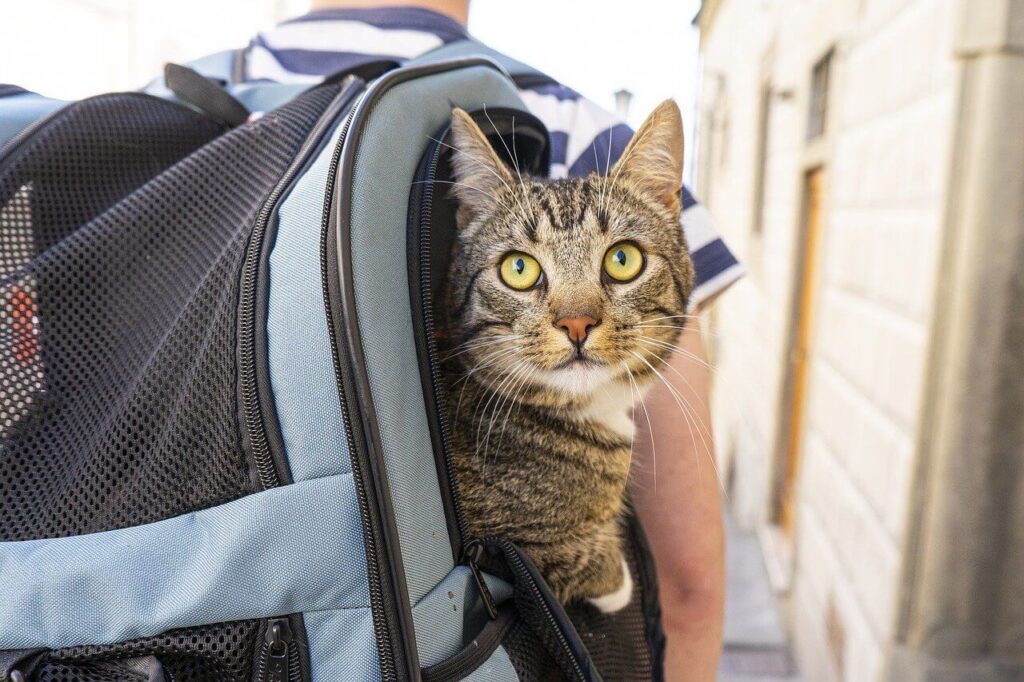
Taking your furry friend on adventures can be fun, but it needs careful planning. Here’s how to make traveling with your cat a breeze:
Carrier Training: Help your cat get used to their carrier by leaving it open at home with treats or toys inside. Gradually increase the time they spend in it to help them feel comfortable and relaxed.
Identification: Keep your cat safe by ensuring they wear a collar with an ID tag containing your contact information. Additionally, consider getting them microchipped for added security. This makes it easier to find them if they get lost during your trip.
Car Travel: When traveling by car, secure your cat’s carrier in the back seat using a seatbelt or a carrier restraint system. This prevents it from moving around and keeps your cat safe in case of sudden stops or turns.
Air Travel: If you’re flying with your cat, research the airline’s pet policies beforehand. Book your cat’s ticket early and ensure their carrier meets the airline’s size and ventilation requirements. Follow all necessary procedures for transporting pets to ensure a smooth journey. [The Association for Pet Travel (APTA): https://www.aphis.usda.gov/pet-travel] can provide more information on pet travel regulations.
Travel Essentials: Pack everything your cat needs for the trip, including food, water, litter, medications, and familiar items from home like bedding or toys. Having these familiar comforts can help reduce your cat’s stress during travel and make them feel more at ease in unfamiliar surroundings.
Know Your Destination: Before you travel to a new location, research pet-friendly accommodations and ensure the destination has everything your cat needs for comfort and safety. This includes suitable lodging, access to veterinary care if needed, and a safe environment for your cat to explore.
Conclusion
Looking after a cat is a wonderful journey. By understanding what they need, making their space cozy, and taking care of their health and behavior, you’re making sure they have a happy life. Don’t forget, your vet is there to help if you need advice.
So, enjoy being a cat owner and treasure every moment with your furry friend! And remember, this guide is just the start. There’s always more to learn about cats, so stay curious, keep learning and loving your pawsome feline friend!


